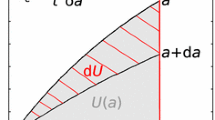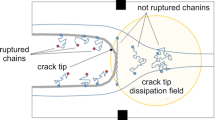Abstract
In this paper, we have verified the validity of some formulations allowing the determination of the fracture surface energy in the case of rubber-like materials. The J-integral is chosen as a fracture characterizing parameter which is experimentally determined by considering a multiplying form that; numerically evaluated using a finite element method. The numerical results are compared to the experimental data and a good agreement has been pointed out for the deeply cracked specimen (a/w≥0.5). Below this limit, a significant divergence is observed which is attributed to a lack of accuracy of the experimental data processing.
Similar content being viewed by others

References
Ait Hocine, N., Nait Abdelaziz, M., Ghfiri, H. and Mesmacque, G. (1996). Evalution of the energy parameter Jon rubber–like materials: A comparison between experimental and numerical results. Engineering Fracture Mechanics 55(6), 919–933.
Ait Hocine, N. (1996). Approche globale de la mécanique de la rupture appliquée aux élastomères:..., Thèse de doctorat de l'Université des Sciences et Technologies de Lille USTL, spécialité Mécanique, 28th May, 133–149.
Andrews, E.H. (1974). A generalised theory of fracture mechanics. Journal of Materials Sciences 9, 887–894.
Begley, A. and Landes, J.D. (1972). The J–Integral as a fracture criterion, in Fracture thoughness, ASTM STP 514, 1–23.
Ghfiri, H., Nait Abdelaziz, M. and Mesmacque, G. (1993). Experimental determination of Jon rubbery materials: Influence of finite dimensions. Engineering Fracture Mechanics 44, 681–689.
Griffith, A.A. (1920). Philosophical Transactions Society, London A221, 163.
Ming Wang, Neng, (1973). Finite element analysis of cut growth in sheets of highly elastic materials. International Journal of Structures 9, 1211–1223.
Mooney, M. (1940). A theory of large elastic deformation. Journal of Applied Physics 11, 582–592.
Naït Abdelaziz, M., Ghfiri, H., Mesmacque, G. and Neviere, R. (1994). The J–integral as fracture criterion of nonlinear behaviour materials: A comparative study between the compliance method and an energy separation method. Fracture Mechanics 25, ASTM–STP 1220, 380–396 (Edited by F. Erdogan and Ronald J. Hartranft).
Murakami, Y. (1987). Stress intensity factors Handbook, Pergamon Press, 6–7.
Pidaparti, R.M.V., Yang, T.Y. and Soedel, W. (1990). Plane stress finite element prediction of mixed–mode rubber fracture and experimental verification. International Journal Fracture 45, 221–241.
Pidaparti, R.M.V., Yang, T.Y. and Soedel, W. (1989). A plane stress finite element method for prediction of rubber fracture. International Journal Fracture 39, 255–268.
Pidaparti, R.M.V. (1994). Finite element analysis of interface cracks in rubber materials. Engineering Fracture Mechanics 47(3), 309–316.
Rice, J.R. (1968). A path independent integral and the approximate analysis of strain concentration by notched cracks. Journal of Applied Mechanics 379.
Rice, J.R. (1968). Mathematical analysis in the mechanics of fracture (Edited by H. Liebowitz). N.Y. London Academic Press 2, 191–311.
Rivlin, R.S. and Thomas, A.G. (1953). Rupture of rubber. Journal of Polymer Sciences 10, 291.
Rooke and Cartwright, D.J. (1976). Compendium of stress intensity factors. Hillington Press, Uxbridge, U.K., 6–7.
Rooke and Cartwright, D.J. (1976). Compendium of stress intensity factors. Hillington Press, Uxbridge, U.K., 84–85.
Rooke and Cartwright, D.J. (1976). Compendium of stress intensity factors. Hillington Press, Uxbridge, U.K., 88–89.
Sharobeam, M.H. and Landes, J.D. (1991). The load separation criterion and methodology in ductile fracture mechanics. International Journal of Fracture 47, 81–104.
Watwood, V.B. (1969). The finite element method for prediction of crack behaviour. Nuclear Engineering and Design 11, 323–332.
Author information
Authors and Affiliations
Rights and permissions
About this article
Cite this article
Hocine, N.A., Abdelaziz, M.N. & Mesmacque, G. Experimental and numerical investigation on single specimen methods of determination of J in rubber materials. International Journal of Fracture 94, 321–338 (1998). https://doi.org/10.1023/A:1007520003294
Issue Date:
DOI: https://doi.org/10.1023/A:1007520003294



